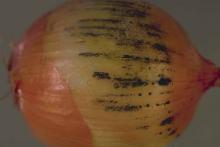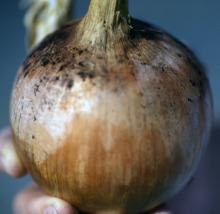By C. M. Ocamb and D. H. Gent
Cause Aspergillus niger,a fungus common in soil and crop debris, affects a large number of fruit and vegetable species. The fungus may be seedborne. The disease attacks colored and white onions in storage and transit. It may do a lot of damage in storage if bulbs were at high temperatures for long periods (such as high-temperature drying in storage more than 2 to 3 days). No resistant varieties are known.
Symptoms Infection usually is through neck tissues as foliage dies down at maturity. Infected bulbs are discolored black around the neck, and affected scales shrivel. Masses of powdery black spores generally are arranged as streaks along veins on and between outer dry scales. Infection may advance from the neck into the central fleshy scales. In advanced disease stages, the entire bulb surface turns black, and secondary bacterial soft rot may make the bulb soft and mushy. No external symptoms may be found with some bulbs.
Cultural control
- Plant seed free of Aspergillus niger.
- Promptly and adequately dry bulbs after harvest, but avoid using heated air, which favors the occurrence of black mold.
- Storing bulbs at low temperatures (35°F to 55°F) and low humidity controls black mold if bulbs are cured properly.
- Avoid bruising bulbs during handling.
- Control other foliar diseases in the field.
Reference Schwartz, H.F., and Mohan, S.K. 1995. Compendium of Onion and Garlic Diseases. St. Paul, MN: APS Press.



